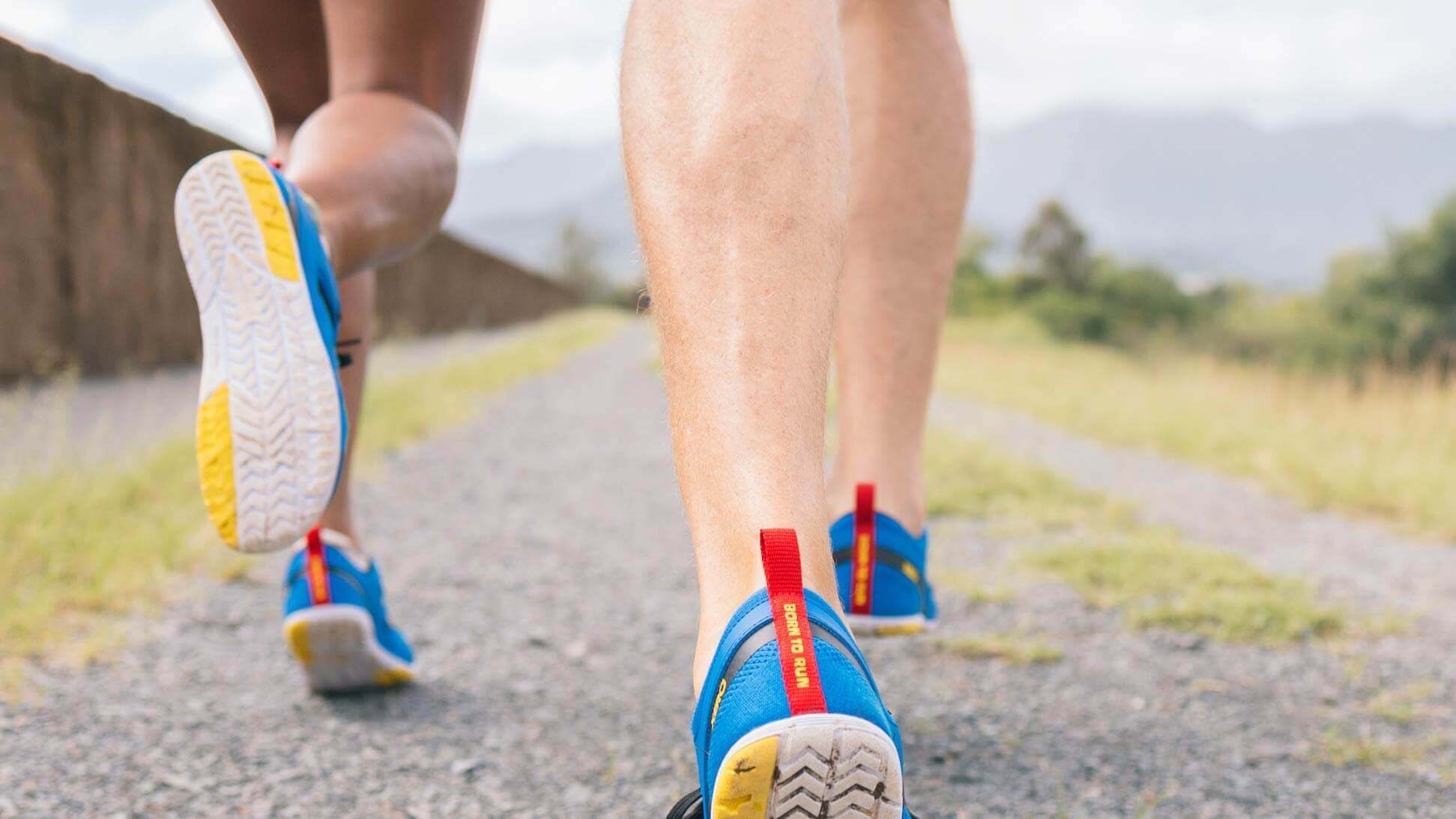
Your Training Guide to Accomplish Your Marathon Goals, With Advice From Professional Running Coaches
Training for a marathon is not easy, and takes dedication and perseverance.
Marathon training will become a full-time lifestyle change if you’re serious about improving your performance. Yes, you will run a lot, but you’ll also want to improve and optimize your diet, sleep schedule, and mental well-being.
You’ll push your body and mind to new lengths, testing your limits. But ultimately, if you don’t care for your body while training, your body won’t take care of you during the race.
The phrase “it’s a marathon, not a sprint” can also be applied to your training. With several months of run training ahead, you will benefit from a long-term approach.
Ready to get started? Here are some marathon training tips from professional running coaches to make your next (or first) marathon your best one yet.
Featured Contributors:
- Jerry Macari
- Amie Dworecki
- Laura Norris
- Amanda Brooks
- Matthew Boyd
- Matthew Silver
Marathon Training
To complete 26.2 miles, you’ll need to train well. Training for a marathon involves significant commitment, preparation, and planning.
When it comes to training, everyone is different. No one’s genetic talent, goals, and health are the same, affecting how you train and the best plan to follow.
Here are some tips to keep in mind that will help you train for a marathon:
- Training plans
- Speed workouts
- The running plateau
- Long runs
- Form and posture
- Warm-ups and cool-downs
- Breathing
- Strength training
- Running gear
- Hydration
- Fuel
- Listening to your body
Training Plans
Proper training is essential to successful marathon training. Because we are all different, there isn’t one strategy or plan that works best for everyone. You’ll want to find the best plan that works best for you.
Each plan will include various types of runs at different paces, intensities, and distances. Choosing the best plan will depend on the following factors:
- current fitness
- running history
- injury history
- short and long-term goals
- work/life balance
Most training plans last 4 to 5 months long. You’ll likely run 3-5 times per week, and have recovery days where you may do light cardio.
Your running plan will increase overall mileage as you progress, preparing you to accomplish your marathon goals on race day.
“Train from where you currently are – not where you want to be. It’s better to reach race day feeling like you could have done more in training, than to feel completely wiped from an aggressive training plan. Look at your current weekly mileage and use that as a starting point for picking a marathon training plan.”

-Laura Norris
“Because we are all individuals, there isn’t one strategy that works best for everyone. The appropriate training depends on multiple factors, including your training history, time you can dedicate, race goals, marathon course, and personal strengths and weaknesses. Rather than mindlessly following a static plan, a good training plan is dynamic and adapts to you, your environment, and fitness level. A common mistake runners frequently make is to use the same training plan repeatedly.”

-Amie Dworecki
Speed Workouts
You may not think you’ll need to focus on sprint speed for marathon training – after all, you’re training for a 26.2-mile run that you’ll need to sustain a consistent pace. But adding speed workouts to your marathon training can be important for performance come race day.
“Always maintain your top end sprint speed. This skill will confirm muscular strength, range of motion and technique resulting in better running economy as well as injury prevention. Workouts like 10 X 100 meters along with weight training should play a critical role in all runners training programs whether you’re a miler or marathoner.”

-Jerry Macari
Long Runs
Your training plan includes your long runs, which help you maximize your mileage as marathon day approaches. These are completed every week to two weeks. Each long run will be longer than the previous week as you progress through your plan. Though they are typically completed at an easy, comfortable pace, the mileage of long runs can make it a tough run. Ultimately, long runs help improve endurance and fight fatigue during a marathon.
“To ensure success on race day, any aspect of training should be mastered by repetition. This includes long runs specific to marathons. Your maximum long run should be achieved as early on in the training process as possible, so it can be repeated to the point of relative ease.”

-Jerry Macari
The Running Plateau
Running plateaus occur when we’re working hard, building endurance, getting faster… and suddenly, the improvement you’re used to seeing each week comes to a halt. Most runners experience this “plateau” to varying degrees. Though it can be a frustrating and demotivating experience, there are a few strategies to work through this.
Tips:
- Consider adding a rest day
- Reduce mileage
- Try more strength training
- Make sure to do a thorough warm up and cool down
- Focus on diet and sleep
- Be patient and stay positive!
Running Form
Your running form matters. The correct form will keep you running efficiently and comfortably, fight fatigue, and prevent common injuries like runner’s knee or IT band syndrome, among others. Here’s how to implement good running form and avoid bad habits during your training.
Tips:
- Keep your head up, and your back straight.
- Pull your shoulders and position them gently backward .
- Keep your tight core as you run to improve your posture.
- Let your arms swing forward to backward instead of side-to-side,
- Keeping a stable torso as you move.
- Have your feet land under your body.
- Make your feet light when they land on the ground. Instead of “plopping” your feet, have them lightly hit the ground, as if you were walking on hot coals.
Warm-Up and Cool Down
Take the time needed to do a proper warm up and cool down as part of your training. Starting your run with warm up exercises keeps the body limber, and prevents injuries. A cool down to end your run boosts your recovery, reduces soreness, and allows your heart rate to return to normal.
Tips:
- Dynamic warm-up exercises: try jumping jacks, knee-to-chest, arm circles, mountain climbers, walking lunges, and opposite toe touches.
- Cool-down static stretches: hip flexor, hamstring, quad and lower back stretches.
- Cool-down cardio: Slow jogs (3-5 minutes), walk or yoga poses.
“One small thing that changes the game for many is the willingness to spend 5-10 minutes on a dynamic warm up. They find that the run immediately feels better, their heart rate doesn’t spike and it’s a great chance to sneak in prehab movements that prevent injuries. This can be as simple as some leg swings, lunges, planks, heel toe walks and then some walking to start.”

-Amanda Brooks
Breathing
Proper breathing is important for marathon training. Breathing during your run helps reduce the chances of fatigue or injury, and helps with efficiency and performance. Focusing on your breathing technique while you run may take some practice to get used to, but will help you achieve your marathon goals.
“A simple breathing exercise called “Breath Anchoring” as part of your marathon training. Start by inhaling for 3 seconds and exhaling for 6 seconds. The goal is to get your body more accustomed to higher levels of CO2 in your bloodstream – higher levels of CO2 actually allow you to use MORE of the oxygen you inhale! First practice these breathing exercises while NOT running, then try them on an easy run. It may be challenging and uncomfortable at first, but should get easier as you continue.”

-Matt Silver
Strength training
When it comes to improving your performance, strength training will be important for runners. Adding a strength training program to your training can help you run faster, avoid injuries, and improve your endurance during long-distance runs.
“Strength training improves running performance and helps prevent injuries. You need to make sure the weight is heavy enough to make you stronger. Aim to incorporate 1-3 sessions per week into your schedule. Focus on compound exercises like squats, lunges and deadlifts. Use weights that are so heavy that you can’t do more than 8 reps per set.”

-Matthew Boyd
“Strength training is an important part of building tolerance to the forces of running and allows you to handle that force especially over a distance like the marathon. Every step you take when running is equivalent to 2x to 2.5x your body weight on one leg…..that’s a lot of force! Three exercises you should be performing throughout the marathon training cycle are the Bulgarian Split Squat, the Deadlift, and the Soleus Calf Raise. Do 5 sets of 5 repetitions 3-4 times a week, then decrease the volume 2 weeks before race day.”

-Matt Silver

Running Gear
Runners need gear to train that is comfortable for training. You won’t get to choose the weather we train in, so you’ll need the best gear to train your best for every possible condition.
Tips:
- In many cases, you should wear less clothing than you think. Too many layers of clothing can lead to dehydration.
- Test out items like socks, shoes, and clothes, so you’re comfortable with them for the big day.
- To avoid chafing, consider opting for quality apparel that fits you well. In addition, there are several skin-treatment products designed specifically for lubricating high-friction areas of the body.
Hydration
Proper hydration should not be overlooked during your training, before, during, and after your runs. Your water intake will help you complete your training and marathon.
Tips:
- Drink at least 400 ml of water per hour while running.
- Throughout the run, fuel with a gel every 25-40 minutes and 8-16 ounces of electrolytes every hour.
- Consider using an electrolyte drink, particularly for a long run or a run on a hot and humid day.
- Monitor the color of your urine. Pale yellow or light straw-colored urine typically indicates great hydration. If you notice a darker yellow or amber-colored urine, it may signal you’re dehydrated, and you should improve your water intake.
- Stay well-hydrated as much as you can, and not just on run days, or in preparation for your run.
“Hydration is one of the overlooked pieces of run fueling. But one of the main reasons many runners struggle with stomach issues on the run is due to dehydration or not enough fluids when consuming gels. So learning to start the run well hydrated and then keep sipping is a big win.”

-Amanda Brooks
Fuel
Fueling properly before and during a run helps support your energy levels and performance. Consider a sports drink or running gel to maintain your endurance on your scheduled long run days.
“While drinking water is helpful before, during and after your runs, focus on drinks that have electrolytes. This doesn’t have to be Gatorade! There are plenty of brands of electrolyte powders that don’t have an excessive amount of sugar in them. Just add water.”

-Matt Silver
“One of the most important things in marathon training is learning how to fuel your long runs. Your body burns carbohydrates for energy while running. If you do not replace those carbs during long runs, you may struggle to complete the distance and recover afterward. The current recommendation is 30-60 grams of carbs per hour as a starting point, from sources such as running gels and sports drinks. Start small: try a gel on a shorter run. As you feel more comfortable, build up so you can take a gel roughly every 25-30 minutes on race day.”

-Laura Norris
Listen to Your Body
Training through pain or injury is counter-productive to improving your performance. A disciplined runner knows when to pause or modify their training to recover from an injury or muscle soreness. You need sleep, rest, and time off to heal and be able to train in the long run.
Tips:
- If you’re too sore or tired, take time off from training.
- Keep a training log of how you’re feeling.
- If you happen to injure yourself from training, monitor your symptoms.
- Consider rest or doing light-intensity cardio – swimming and biking or two great alternatives.
- Modify your training as your body needs.
“Aches and pains with marathon training are inevitable. We runners often call them ‘niggles.’ We need a strategy to make sure we don’t develop a full injury. I recommend using what I call ‘pain traffic lights’.
- Green Pain (0-3 scale) means you should continue training but get it checked by a Physio
- Orange Pain (4-7 scale) means modify training and work with a Physio
- Red Pain (7-10 scale) means stop training and start rehabilitation
By following these ‘pain traffic lights’, you can take the necessary action to prevent further injury.”

-Matthew Boyd

Training Recovery:
Training for a marathon can be exhausting both physically and mentally. You’re putting your body through a lot during a four-month span of time.
Recovery will play a pivotal part in marathon training. Proper recovery helps you sustain performance over a long period of time, helping you bounce back quicker and reduce your chances of injury.
Here are some tips for recovering from marathon training:
- Rest days
- Stretching
- Massage and foam rolling
- Light cardio
- Nutrition
- Hydration
- Sleep
- Burnout
Rest Days
Rest days are critical for marathon training. Runners should take at least one rest day per week to focus on recovery from your running. Rest days are essential for your physical and mental health as you train. Your body needs the time necessary to rest between runs.
A worn down body can lead to fatigue, making you more prone to injury. Fatigue from training can also lead to a lack of motivation during your training plan. So, take the time necessary to rest up because your body will thank you in the long run.
“All recreational marathoners will benefit from one rest day per week. A rest day allows your body to recover on a cellular level – and it is during this recovery that you actually adapt to training. A rest day is truly a rest day: no cross-training, strength training, or strenuous activity. Some runners may even do best with two rest days per week, depending on their experience level and life stress.”

– Laura Norris
“Running doesn’t make you fitter. Running and resting make you fitter. Getting the balance between running and rest can be tricky, but a helpful guideline is to reduce your weekly mileage by 25-50% every fourth week during your training program. This allows your body an opportunity to adapt to the training and get fitter.”

-Matthew Boyd
“While many define their training by the amount of running, the actual amount of productive exercise is usually far less. Easy days to fill in mileage goals do very little to improve fitness and can actually be counter-productive at times as they don’t allow for real recovery or adaptation. Consider replacing an easy day of running low mileage with a full rest day and view it as a pro-active smart choice.”

-Jerry Macari
Stretching
Stretching is an important part of your warm-up and cool-down when you run. Stretching on recovery days is also important because it can reduce muscle soreness and promote quicker recovery. Include stretching as part of your daily or weekly routine.
Tips:
Use these stretches as part of your training:
- Low lunge stretch
- Hamstring stretch
- Butterfly stretch
- Quad stretch
- Calf stretch
Light Cardio
Low-intensity cardio helps improve blood flow and keeps muscles loose, without adding significant stress to the body. Light cardio can be done at about 50% of your maximum heart rate, and worked into an active recovery day, incorporated 1-2 times per week depending on your recovery rate. Try to include walking, yoga, mobility work, swimming, and light biking to get some light cardio work into your routine.
Nutrition
If you want to get the most out of training, your diet should be optimized to help you improve your performance. Some runners may not fully consider the importance of nutrition to support their training. If you find that your training has stalled, or you are feeling more aches and pains, it could be improper nourishment. Eating the right foods will keep your training going successfully.
Tips:
- Carbohydrates provide energy for your runs and workouts. Prepare meals with whole grains, vegetables, legumes, and tubers.
- Healthy fats are good sources of dietary fat for runners. This includes nuts and nut butters, seeds, coconut, avocado, fatty fish and fish oils, and healthy oils like olive oil and flaxseed oil.
- Inflammatory foods will slow down your recovery. Anti-inflammatory foods like tomatoes, spinach, kale, and collards, almonds and walnuts, salmon, strawberries, and blueberries can help reduce inflammation.
“Nutrition is something marathon runners may incompletely consider during training. The wrong fueling can harm overall health because the high volume of energy that marathon training requires can create nutritional deficiencies. Conversely, incorrect fueling can cause excess hunger at the wrong times, leading to unexpected marathon weight gain as your mileage builds. Runners should focus on the amount and timing of their fueling – before their runs, during, and after. Additionally, runners should consider the amount they eat each day and their macronutrient composition (how much of the energy comes from carbohydrates, protein, and fat) to ensure their energy is where it needs to be.”

-Amie Dworecki
Hydration
Staying hydrated is essential for runners. Running and sweating increases the amount of water needed. Dehydration can impact your level of performance during training, especially after those hot and grueling runs. Staying hydrated before, during and after your runs will help with endurance and performance.
Tips:
- Drink about 2-3 ml per pound of body weight at least 4 hours before your run.
- Drink at least 400 ml of water per hour while running.
- After your run, the American Council on Exercise recommends that you drink 16–24 fluid ounces for every pound lost while running or exercising.
Sleep
For long-distance runners, sleep is an important part of training to prioritize – particularly for those with busy schedules. Quality sleep starts with sticking to a consistent sleep schedule. You should plan to get 7-9 hours of sleep per night during your training.
Tips:
- Avoid excessive phone use before bed (this can be a difficult habit to break). Consider reading a book instead.
- If you wake up and can’t get back to sleep, use natural sleep aid remedies like warm milk, and chamomile tea, which is caffeine-free.
- Blackout curtains make sure your room remains dark, which should help you get better sleep.
- Room temperature should be slightly cool, ideally between 60-70 degrees.
“Busy lifestyles can simultaneously help us think we can shorten our sleep without much consequence; yet, this can demolish your marathon goal instead. Sleep has performance-enhancing benefits, and improving the quality and quantity of sleep may give you the biggest bang for your buck. One aspect often not considered is not only the amount, but the timing. Our internal circadian clock controls the optimal function of our entire bodies, and maintaining the same bedtime and wake-up time keeps this circadian timing on track so you can function, recover, and perform your best in your running (and life!).”

-Amie Dworecki
Mental Health & Burnout
Mental rest helps prevent burnout and fatigue. You’re spending months training and sacrifice, and you want to remain dedicated and enthusiastic during your training!
Tips:
- Spend some quality time with family and friends.
- Re-find your marathon motivation – what’s your reason for running the marathon? Keep sight of the end goal and your reason for running a marathon.
- Enjoy the process! Celebrate your wins and successes along the way to your ultimate goal.
“Burnout is all too common in marathon training. 20 weeks can be a very long time and the weekend miles start to feel extra long. That’s when it’s important to make sure you aren’t running too hard on your easy days and to come back to the fun of running. Trying new routes, going with friends, picking a new podcast, whatever it takes to keep training enjoyable.”

-Amanda Brooks

Get Training and Good Luck!
Completing a marathon is challenging, which is what makes it so special when you cross the finish line. Reaching your marathon goals is only possible with proper training. Follow these marathon training tips and enjoy the process.
How to use barefoot running for marathon training
Most high-level marathon runners use barefoot training for various benefits.
Quite a few even run marathons and ultramarathons in barefoot shoes (and sandals!)
If you are unfamiliar with barefoot shoes, they are different from your normal running shoes.
Unlike “normal” running shoes with elevated heels, pointy toe boxes, stiff soles, and unnecessary padding, these are minimalist-style shoes that mimic being in bare feet
Here’s how barefoot shoes can help with marathon training:
- Active recovery – with a flexible sole, wearing a barefoot shoe can aid blood flow and muscles and tendons moving.
- Foot strength – Research shows that merely walking in a barefoot shoe builds foot strength. And further research shows this strength can reduce the risk of running injuries by 250% over the course of a year. A free ebook detailing these studies is at https://footweartruth.com/250/
- Instant feedback – barefoot shoes provide your body instant feedback on running form, which can improve efficiency.
- Lightweight – barefoot shoes weigh less than typical shoes; therefore, should you choose to run in them, you’ll be using less energy to move your feet.
Want to try a pair of shoes or sandals? Click here to see the range of casual and performance shoes, boots, and sandals from Xero Shoes.
Interested in adding some barefoot-inspired training? Click here to learn how to run barefoot.
Thanks for reading, and best of luck to everyone!
Our Contributors
A special thank you to the running coaches who contributed to this article. Meet the contributors here.

Laura Norris
Laura Norris is a certified running coach, personal trainer, and sports nutritionist. She has her master’s degree in Applied Exercise Science and has been coaching runners for seven years. She regularly publishes training tips at Laura Norris Running. She is a runner herself, with a marathon PR of 3:29 and a half marathon PR of 1:34.
Laura’s Marathon Training Tips:
- Train from where you currently are, not where you want to be.
- Replace those carbs your body burns during long runs
- Take rest days that are truly rest days at least once per week
Website: lauranorrisrunning.com | Instagram: @lauranorrisrunning

Jerry Macari
Jerry Macari is the founder and head coach of Urban Athletics NYC. He has 35 years of coaching experience, having received the first issued USATF coaching certification in 1986. He has coached countless runners to PRs and guided multiple New York Road Runners Runner Of The Year and nominees, National USATF Champions and medal winners. He has been voted New York Road Runners Master Runner Of The Year, been nominated numerous other times, and been awarded the USATF Open Road Runner Of The Year. His vast experience and knowledge have helped runners attain their running goals.
Jerry’s Marathon Training Tips:
- Maintain your top end sprint speed.
- Achieve maximum long run as early on in your training.
- Replacing an easy day of running low mileage with a full rest day.
Website: urbanathleticsnyc.com | Instagram: @urbanathleticsrunclub

Amanda Brooks
Amanda Brooks is a long time running coach and founder of RunToTheFinish.com. She’s worked with thousands of middle of the pack runners to avoid injuries, find the fun in running and hit their goals.
Amanda’s Marathon Training Tips:
- Spend 5-10 minutes on a dynamic warm up before a runs
- Stay hydrated when consuming gels
- Try new things to make your training enjoyable
Website: runtothefinish.com | Instagram: @runtothefinish

Amie Dworecki
Amie Dworecki is CEO and Head Coach of Running with Life, LLC, a professional holistic run coaching company. She has obtained six certifications in run coaching and has over three decades of experience as a coach and trainer. She is a former World Record Holder for running marathons on all continents with 43 years of running experience as a multiple-time qualifier for the Boston Marathon and Western States Ultramarathon. Since 2015, she has helped runners prevent injuries and transform their fitness and performance to reach their goals and feel amazing with holistic, online marathon and trail/ultra run coaching.
Amie’s Marathon Training Tips:
- Maintain the same sleep scheduled to keep your circadian timing on track.
- A good marathon training plan is dynamic and adapts to you, your environment, and fitness level.
- Focus on the amount and timing of their meals in relation to their runs.
Website: runningwithlife.com | Instagram: @runwlife

Matthew Silver
Dr. Matthew Silver is a running coach, educator, physical therapist, and founder of Alpha Project Phyzio & Performance based in Maryland. As a distance runner of 15 years, he works directly with other long distance runners to help them remain injury-free.
Matthew’s Marathon Training Tips:
- Practice “breath anchoring” – inhale for 3 seconds and exhale for 6 seconds.
- Incorporate Bulgarian Split Squat, the Deadlift, and the Soleus Calf Raise for strength training.
- Focus on drinks with electrolytes.
Website: alphaprojectphyzio.com | Instagram @alphaprojectphyzio

Matthew Boyd
Matthew Body is a physiotherapist and running coach that works directly with injured runners to help them get back to running.
Matthew’s Marathon Training Tips:
- Strength training with heavy enough weights will improve running performance.
- Use the “pain traffic light” to scale the severity of an injury.
- Rest is an important part of getting fitter.
Website: matthewboydphysio.com | Instagram @matthewboydphysio











 Fostering honest and responsive relationships between businesses and consumers.
Fostering honest and responsive relationships between businesses and consumers.










